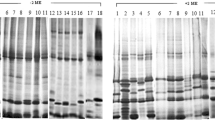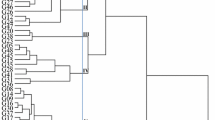Summary
An isoenzyme survey of some taxa in the genus Lotus (Fabaceae) was undertaken to increase the number of genetic markers available to breeders and to students of Lotus phylogeny. Twenty-one enzymes were examined using starch gel electrophoresis and nine buffer systems. Clear, consistent banding patterns were obtained for PGI, TPI, MDH, IDH (NADP), PGM, 6-PGDH, and ME. Clear but inconsistent banding patterns were obtained for FDP, G3PDH (NADP), β-EST, LAP, MDH, DIA, and NADHDH. Phenotypes of the seven consistently resolved enzyme systems were obtained for different tissues for each of several genotypes at different stages of development. Variation in enzyme phenotypes of the same individuals under different growth conditions indicated the presence of different isozymic forms of these enzymes. Shoot tissue of plants over 6 weeks of age was found to be suitable material for further genetic studies, since phenotype for this tissue was constant despite changes in growing conditions. A formal genetic analysis of segregation and/or recombination of allozymes for the enzymes PGM, TPI, MDH, IDH, and 6-PGDH was undertaken. Isoenzyme phenotypes were examined for the diploids L. alpinus Schleich., L. burttii Sz. Borsos, L. conimbricensis Brot., L. ornithopodioides L., L. tennis Waldst. et Kit., and L. uliginosus Schkuhr; and for the diploid interspecific hybrids L. alpinus x L. conimbricensis, L. burttii x L. ornithopodioides, and L. japonicus x L. alpinus. Several new loci were identified for Lotus, namely, Idh1, Idh2, Mdh3, Pgi1, Pgi2, Tpi1, Tpi2, and 6-Pdgh1. Duplications of loci of IDH, MDH, PGI, and 6-PGDH were detected in the diploid (2n=12) interspecific hybrid L. japonicus x L. alpinus.
Similar content being viewed by others
References
Ayala FJ, Hedgecock DG, Zumwalt S, Valentine JW (1973) Genetic variation in Tridacna maxima, an ecological analog of some unsuccessful evolutionary lineages. Evolution 27:177–191
Bubar JS, Miri RK (1965) Inheritance of self-incompatibility and brown keel tip in Lotus corniculatus L. Nature 205:1035–1036
Buzzell RI, Wilsie CP (1963) Genetic investigations of brown keel tip color in Lotus corniculatus L. Crop Sci 3:128–130
Cardy BJ, Stuber CW, Goodman MM (1981) Techniques for starch gel electrophoresis of enzymes from maize (Zea mays L.). Institute fo Statistics Mimeographed Series No. 1317, North Carolina State University, Raleigh/NC, 31 pp
Cheliak WM, Pitel JA (1984) Techniques for starch gel electrophoresis of enzymes from forest tree species. Information Report PI-X-42, Petawawa National Forestry Institute, Can For Serv, 49 pp
Clayton JW, Tertiaak DN (1972) Amine citrate buffers for pH control in starch gel electrophoresis. J Fish Res Board Can 29:1169–1172
Darlington CD, Wylie AP (1955) Chromosome atlas of flowering plants. Hafner, New York, 519 pp
Dawson CDR (1941) Tetrasomic inheritance in Lotus corniculatus L. J Genet 42:49–73
De Lautour G, Jones WT, Ross MD (1978) Production of interspecific hybrids in Lotus aided by endosperm transplants. N Z J Bot 16:61–68
Donovan LS, McLennan HA (1964) Further studies on the inheritance of leaf size in broadleaf birdsfoot trefoil, Lotus corniculatus L. Can J Genet Cytol 6:164–169
Fildes RA, Harris H (1966) Genetically determined variation of adenylate kinase in man. Nature 209:261–263
Gottlieb LD (1981) Electrophoretic evidence and plant populations. Prog Phytochem 7:1–46
Gottlieb LD (1982) Conservation and duplication of isozymes in plants. Science 216:373–380
Grant WF (1986) The cytogenetics of Lotus (Leguminosae). J Nat Hist 20:1461–1465
Grant WF, Marten GC (1985) Birdsfoot trefoil. In: Heath ME, Metcalfe DS, Barnes RF (eds) Forages: Science of grassland agriculture, 4th ed. Iowa State University Press, Ames/IA, pp 98–108
Grant WF, Bullen MR, Nettancourt D de (1962) The cytogenetics of Lotus. I. Embryo-cultured interspecific diploid hybrids closely related to L. corniculatus. Can J Genet Cytol 4:105–128
Harney PM, Grant WF (1965) A polygonal presentation of chromatographic investigations on the phenolic content of certain species of Lotus. Can J Genet Cytol 7:40–51
Kahler AL, Lay CL (1985) Genetics of electrophoretic variants in the annual sunflower. J Hered 76:335–340
Kiang YT, Gorman MB (1985) Inheritance of NADP-active isocitrate dehydrogenase isozymes in soybeans. J Hered 76:279–284
May B (1980) The salmonid genome. Evolutionary restructuring following a tetraploid event. PhD Thesis, Pennsylvania State University, State College/PA
O'Donoughue LS, Grant WF (1988) New sources of indehiscence for birdsfoot trefoil (Lotus corniculatus, Fabaceae) produced by interspecific hybridization. Genome 30:459–468
O'Malley D, Wheeler NC, Guries RP (1980) A manual for starch gel electrophoresis. University of Wisconsin, Department of Forestry, Staff paper no. 11, Madison/WI, 16 pp
Østergaard H, Nielsen G (1981) Cultivar identification by means of isoenzymes. I. Genotypic survey of Pgi2 locus in tetraploid ryegrass. Z Pflanzenzücht 87:121–132
Peacock HA, Wilsie CP (1957) Selection for resistance to seed pod shattering in birdsfoot trefoil (Lotus corniculatus L.). Agron J 49:429–431
Peacock HA, Wilsie CP (1960) Selection for vegetative vigor and seed setting in birdsfoot trefoil (Lotus corniculatus). Agron J 52:321–324
Phillips RL, Keim WF (1968) Seed pod dehiscence in Lotus and interspecific hybridization involving L. corniculatus L. Crop Sci 8:18–21
Poostchi I, MacDonald HA (1961) Inheritance of leaf color in broadleaf birdsfoot trefoil. Crop Sci 1:327–328
Ridgway GJ, Sherburne SW, Lewis RD (1970) Polymorphisms in the esterases of Atlantic herring. Trans Am Fish Soc 99:147–151
Ross MD, Jones WT (1985) The origin of Lotus corniculatus. Theor Appl Genet 71:284–288
Schaal BA, Anderson WW (1974) An outline of techniques for starch gel electrophoresis of enzymes from the American oyster, Crassostrea virginica Gmelin. Georgia Marine Sci Ctr Tech Rept Ser 74-3, 17 pp
Seaney RR, Henson PR (1970) Birdsfoot trefoil. Adv Agron 22:119–157
Somaroo BH (1970) A cytogenetic study of interspecific diploid hybrids and amphidiploids in the genus Lotus. PhD Thesis, McGill University, Montreal, Quebec, Canada 295 pp
Somaroo BH, Grant WF (1971) Interspecific hybridization between diploid species of Lotus (Leguminosae). Genetica 42:353–367
Tanksley SD, Orton TJ (1983) Isozymes in plant genetics and breeding, part B. Elsevier, Amsterdam New York, 472 pp
Tanksley SD, Zanier D, Rick CM (1981) Evidence for extensive overlap of sporophytic and gametophytic gene expression in Lycopersicon esculentum. Science 213:453–455
Vallejos CE (1983) Enzyme activity staining. In: Tanksley SD, Orton TJ (eds) Isozymes in plant genetics and breeding, part A. Elsevier, Amsterdam New York, pp 469–516
Warwick SI, Gottlieb LD (1985) Genetic divergence and geographic speciation in Layia (Compositae). Evolution 39:1236–1241
Weeden NF (1983) Plastid isozymes. In: Tanksley SD, Orton TJ (eds) Isozymes in plant genetics and breeding, part A. Elsevier, Amsterdam New York, pp 139–156
Weeden NF, Gottlieb LD (1980) Isolation of cytoplasmic enzymes from pollen. Plant Physiol 66:400–403
Wolf PG, Haufler CH, Sheffield E (1987) Electrophoretic evidence for genetic diploidy in the bracken fern (Pteridium aquilinum). Science 236:947–949
Zandstra II, Grant WF (1968) The biosystematics of the genus Lotus (Leguminosae) in Canada. I. Cytotaxonomy. Can J Bot 46:557–583
Author information
Authors and Affiliations
Additional information
Communicated by H. F. Linskens
Rights and permissions
About this article
Cite this article
Raelson, J.V., Grant, W.F. An isoenzyme study in the genus Lotus (Fabaceae). Experimental protocols and genetic basis of electrophoretic phenotype. Theoret. Appl. Genetics 77, 595–607 (1989). https://doi.org/10.1007/BF00274286
Received:
Accepted:
Issue Date:
DOI: https://doi.org/10.1007/BF00274286




